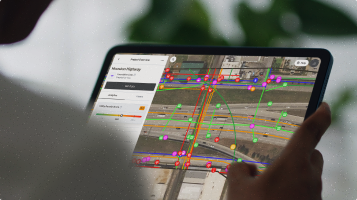Utility Marking Symbols - What Are the Color Codes for Utilities?
Written by

Published on
November 7, 2022


Table of contents
Whenever you require excavation or digging for a project, it is necessary to use colored utility flags to identify utility lines below the surface. Home and landowners are often surprised to see colored flags in their yards. These flags are utility marking symbols that help those who work in the adjacent area to know what kind of utilities exist under the ground before digging.
Engineers and contractors often have subsurface utilities marked out so that there is no damage to them during the digging process. This helps eliminate expensive repairs, delays in project completion, and mitigates safety risks.
In this article, we take a look at the different kinds of utility flags, and the context in which they are used.
Why do utility companies use temporary colored flags to designate the location of underground utilities?
In every inhabited and uninhabited place, there is likely to be an extensive network of utility lines and subsurface infrastructure put up by different industries. Each industry vertical has a color designated to it, so there is no confusion regarding the subsurface infrastructure below the ground. Utility companies use temporary colored flags to help identify the exact kind of subsurface infrastructure that exists under the surface before any digging project begins. This helps ensure no damage occurs to existing and identified utility lines. It also prevents damage to nearby communities and safeguards construction workers.
Companies that leave these utility markings and color-coded flags usually subtly leave their contact information on the same flags. This proves to be useful to landowners who may have questions about why flags have been posted on their property.
What do colored flags in a yard mean?
If there are colored flags in a yard, a digging project is underway somewhere nearby. This does not mean that the property will be damaged or dug around. It just means that the engineers and contractors are being extra careful to keep utilities under the particular property in mind so that their digging does not interfere with the subsurface infrastructure.
Color-coded flags ensure that construction (EPC) contractors (”EPC contractor”) and project managers can mitigate risks, and safeguard existing subsurface utilities. As each flag has a different color, it clearly conveys what lies underneath. Thus, it becomes easier to prevent damage and minimize risks.

What do the different color flags mean?
Flags typically follow a color code set by the American Public Works Association (APWA) to maintain uniformity and be easily recognizable to professionals. Let us take a quick look at what each of the color-coded flags means.
What do red utility flags mean?
Sometimes, one may see red flags all over their yard. Red utility flags are used to mark underground electric and cable lines. As electricity lines involve great danger to digging personnel and people living nearby, cables and power lines are marked in red. Marking power lines connecting to a grid can eliminate the risk of a wide power outage or electrocution.
What do white flags mean?
White flags will mark the area where an excavation will take place. The more number of white flags one sees in an area, the larger the extent of the crater. Prior permissions from utility owners and government authorities are usually received before such excavations occur. Utility coordination is a huge part of this exercise, and one can assume that prior consultations have been taken, and permissions have been granted before white flags can be stuck.
What do pink utility flags mean?
Temporary survey markings have pink flags stuck on them. They are also used when contractors and engineers suspect utilities underneath but cannot confirm them. Thus, potentially unidentified utilities will also see pink flags on top of them. Unfortunately, there is always a risk of abandoned or unidentified utilities lurking below the surface of a pin flag. Hence, it is necessary to use more modern tools such as AI utility mapping software.
What do yellow utility flags mean?
Just like red flags denote danger in terms of electricity, yellow flags denote gas, petroleum, steam, and other harmful elements that may cause explosions or soil contamination. These flags help safeguard construction workers and prevent accidental leakage of poisonous gasses, which may harm nearby communities.
What do orange utility flags mean?
As there is a growing network of 4G and 5G networks, there has been a lot of effort to provide last-mile connectivity to homes. As a result, there is a complex network of communication lines underground, even in the most remote corners of the world. There is a vast network of telecommunication cables and optical fiber underground. In addition, there could be TV cables as well. Orange flags mark these utility lines. This ensures there is no disruption to communication lines.
What do blue utility flags mean?
Blue, as one may imagine, denotes water. Blue flags are placed on top of water mains and pipelines, including those related to irrigation and slurry. However, blue flags are mostly placed on top of channels that supply drinking water to homes. Blue flags eliminate the risk of damage to water mains, resulting in flooding or water shortage until the pipes are fixed.
What do purple utility flags mean?
Recycled water from sewage and waste is often used for irrigation. This kind of water pipeline is marked in purple. Marking these pipelines using purple flags helps ensure that in the event of breakage during digging, contractors and engineers can make efforts to ensure that it does not contaminate drinking water mains.
What do green utility flags mean?
There is a vast network of sewers and drain lines underground. These pipelines are marked using green flags. This helps ensure that sewer and drain pipelines are not damaged during the digging process, which could emit toxic gasses. It could also flood the community with contaminated fluids.
What happens once the flags have been placed on points where utilities lie underneath?
811 keeps track of underground water and sewer lines and other utility lines. According to the laws of Texas, diggers need to call 811 if they plan to break ground deeper than 16 inches. Usually, utility owners register their subsurface assets with 811. When someone plans to excavate in a particular area, 811 sends its personnel to mark areas with known subsurface utilities. Like those described above, these utilities are marked by utility flags, which have a simple system of color codes.
Once the underground utilities have been marked and flagged under appropriate colors, 48 hours must pass. After this, engineers and contractors may begin the digging or excavation project. However, there are a few requirements that should be kept in mind. These are:
- There has to be a gap of 2 feet between an unexposed underground utility that has been marked and the point where electricity-operated equipment will be used to break ground.
- If the digging needs to be done within 2 feet of a flagged point, the process must be done using hand-held tools with extra precautions.
- If the excavator suspects an underground utility line has been damaged, it is his responsibility to inform the utility company immediately. Not doing so has legal ramifications.
- If the excavators or engineers suspect an imminent danger to the utility lines, construction workers, or the community nearby, they must call 911 immediately.
When can one remove utility flags from a yard?
It is not legal to move the flags that denote underground utilities once they have been placed. For instance, the Pennsylvania Underground Utility Line Protection Act (Act 287) clarifies that nobody will be allowed to tamper with or remove a marking intentionally. Tampering with utility markings will be considered negligence by the Utility Commission and may lead to hefty fines and penalties.
If you are an EPC contractor, color-coded utility flags may not be enough.
If you are an engineering, procurement, and construction (EPC) contractor, you will probably shoulder a lot of responsibility to complete your digging project in time, without incurring additional costs. You will also need to ensure that there are no legal complications arising from the project. While color-coded flags can help identify existing utilities underground, they cannot get a complete picture of what lurks below the surface you are trying to break.
Several abandoned and unidentified utility lines and subsurface infrastructure cannot be flagged under any of the color codes mentioned above simply because 811 and other utility mapping solutions do not have sufficient data. To allay the fears of home and landowners and to ensure that there is no risk to either identified or unidentified utility lines, it is necessary to consider using an artificial intelligence-enabled utility mapping solution.
Why you need AI-powered utility mapping solutions
AI-powered Utility mapping solutions such as 4M Analytics help you pinpoint the exact location of both identified and unidentified subsurface utility lines in real time. This ensures you can plan well ahead to mitigate risks and move utilities if necessary. This also gives you ample time to implement utility coordination with utility owners, governmental authorities, and project owners.
As a result, you will be able to honor your contract and deliver your projects in time without having to worry about missed opportunities and incorrectly flagged utility markings.
Contact us today to learn more about 4M Analytics’ Utility Mapping Solution and how they fare better than traditional color-coded flags.

Recent blog posts

Our Newsletter
Join 7k infrastructure professionals
Get monthly insights on ways to build smarter, faster and safer with Utility AI.

.avif)




